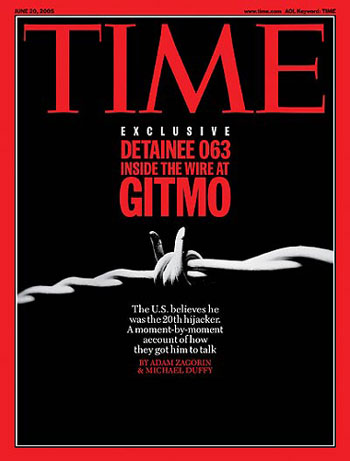Notes
Under the Wire

I know Cheney promised to string up the next Administration official who dared suggest bailing on Guantanamo. This cover, though, demonstrates the boldness (or perhaps, the foolishness) of such a stance.
TIME doesn’t do these dramatic black covers very often. When they do, they typically signify a defining moment involving the elevation of some person, event or issue to the status of an icon.
After the tsunami hit South Asia last December, the magnitude of the humanitarian response led TIME to give it similar treatment (The Events of December 26th, 2004 – link). Coincident with that cover, the standing of "the tsunami" literally become "THE TSUNAMI."
Although the newsmagazines certainly don’t have the impact or the authority they once did, I do think this type of cover has a singular impact. Just watch. The significance of the moment (whether partly defined by TIME, or just affirmed), is that it is no longer "Guantanamo" or " just" Guantanamo. It’s now "GITMO" — like a permanent monument (or an official stain).
I’d like your interpretations and associations to this cover. In the meantime, here are a few of mine:
I get such a base feeling when I hear and think about these detentions.
Although it doesn’t map perfectly, I thought the "barb" strongly evokes
a human hand. The piece sticking up on the left looks like a "little
finger." The coils in the center could be wrapped fingers or a hand
encircling the wire. And the part sticking up on the right suggests a
thumb. The smooth, light saturated twists also have a physical quality
to me. In the segment to the right of the barb, I can imagine the shape
of a shoulder.
…And if it doesn’t accurately map to a hand, maybe that works too. It
says, all who have hands involved in this have been damaged, misshapen.
The other thought about the barb was that it reminded me of a manacle.
Clearly, the story of Dilawar, the taxi driver who was tortured to
death at Bagram (Your Turn: Exhibit Q – link), is still fresh in my mind.
Finally, even without the phrase "INSIDE THE WIRE" in the headline, the
layout emphasizes the black void below or underneath the wire. Below
the wire is where the prisoners are supposed to be — except we are
unable to see anything. Like the prisoners in legal limbo, the
suggestion is that we — the public — are also relegated to the dark.
(image: David Moore/Photonica. June 20, 2005. Time Magazine cover)


Reactions
Comments Powered by Disqus